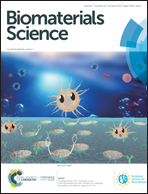3D printing with peptide–polymer conjugates for single-step fabrication of spatially functionalized scaffolds†
Abstract
Biodegradable polymer-based scaffolds are widely used to provide support during early stages of regeneration and can be functionalized with various chemical groups or bioactive cues to promote desired cellular behavior. However, these scaffolds are often modified post-fabrication, which can lead to undesired changes and homogeneously distributed chemistries that fail to mimic the spatial biochemical organization found in native tissues. To address these challenges, surface functionalization can be achieved by 3D printing with pre-functionalized biodegradable polymers, such as peptide-modified polymer conjugates, to control the deposition of preferred chemistries. Peptide–PCL conjugates were synthesized with the canonical cell adhesion peptide motif RGDS or its negative control RGES and 3D printed into scaffolds displaying one or both peptides. The peptides were also modified with bioorthogonal groups, biotin and azide, to visualize peptide concentration and location by labeling with complementary fluorophores. Peptide concentration on the scaffold surface increased with increasing peptide–PCL conjugate concentration added to the ink prior to 3D printing, and scaffolds printed with the highest RGDS(biotin)-PCL concentrations showed a significant increase in NIH3T3 fibroblast adhesion. To demonstrate spatial control of peptide functionalization, multiple printer heads were used to print both peptide–PCL conjugates into the same construct in alternating patterns. Cells preferentially attached and spread on RGDS(biotin)-PCL fibers compared to RGES(azide)-PCL fibers, illustrating how spatial functionalization can be used to influence local cell behavior within a single biomaterial. This presents a versatile platform to generate multifunctional biomaterials that can mimic the biochemical organization found in native tissues to support functional regeneration.



 Please wait while we load your content...
Please wait while we load your content...